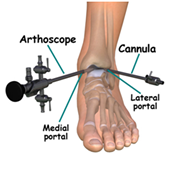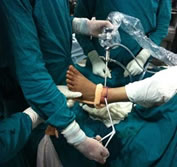

Ankle Arthroscopy is a procedure where a smallvideo camera attached to a fiberoptic lens is inserted into the ankle joint to allow surgeon to see without making a large incision. Arthroscopy is now used to evaluate and treat ankle problems. The ankle joint is one of the common joints that arthroscopy is used to evaluate and treat problems with this minimally invasive technique.


As with most orthopaedic conditions, there are conservative and surgical treatment options. Many orthopaedic patients with ankle injuries or ankle pain will respond well to conservative treatments like: rest, over the counter pain medication, or physical therapy. However, if these measures fail, further diagnostic testing is completed to see if a patient is a good candidate for ankle arthroscopy.
Although most commonly performed in the knee and hip, arthroscopic ankle surgery may be a good treatment option for certain types of ankle pain and conditions. Some of the reasons a patient may undergo arthroscopic ankle surgery include:
For most patients, ankle arthroscopy will help reduce pain and discomfort and improve ankle function. Walking, running and playing sports should become easier and less painful after recovery. The advantages of arthroscopic surgery over traditional surgery include:
How fast a patient recovers from ankle arthroscopy depends on what part of the ankle underwent surgery and what types injuries or conditions were being treated. Typically the more complex the surgery is, the longer the healing and recovery time will be.
Immediately following surgery your doctor may prescribe the RICE regimen: rest, ice, compression and elevation (keeping the ankle elevated to reduce swelling). Your doctor may also instruct you to keep your surgical incisions covered, clean and dry up to two weeks following the procedure. It is also advised that patients avoid smoking and eat a healthy, balanced diet to increase the rate of healing and recovery.
Following arthroscopic ankle surgery certain tasks are unsafe or painful to execute. Such tasks may include:
Most patients can expect to return to school or a sedentary job about four weeks after surgery, sometimes sooner. However, patients that have a job that requires a significant amount of standing or walking may not be able to return to work for two months after ankle arthroscopy. If you have an extremely physical job you will be given more specific estimations from your doctor, as the expected time can vary greatly depending on the reason for the surgery and the nature of your job.
Many orthopedic surgeons have their patients take part in formal physical therapy after any type of ankle arthroscopy procedure. Typically, the more complex the surgery the longer the rehabilitation process will be. Some patients have a preoperative visit with their physical therapist where they are taught how to walk safely using crutches or a walker post-surgery. They also may learn some of the exercises that will be done throughout recovery. The first few physical therapy treatments after surgery are designed to help control the pain and swelling from the surgery. These early sessions also teach patients how to use of crutches or a walker safely if they were not taught prior to surgery. However, overtime, goals of physical therapy will expand to include:
After recovery is nearly complete, physical therapy will end. The therapist will continue to be a resource, but the patient will need to continue doing exercises at home to complete the rehabilitation process.
Although physical therapy regimens will vary from patient to patient some of the exercises done through physical therapy and at home may include: